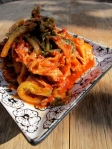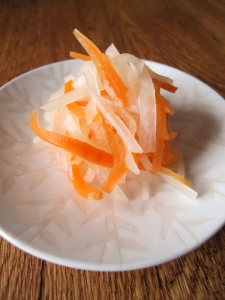Pickles are an integral part of Japanese cuisine. Eaten with virtually every meal, pickles provide balance of flavour or are used as a palate cleanser, as is the case when eating sushi. Also considered a key element to maintaining a healthy diet, it should come as not surprise that the Japanese are somewhat fanatical about their pickles!
Commonly referred to as tsukemono, there is seemingly no end to what the Japanese will pickle or preserve! Often eaten as a side dish or as a garnish, virtually no vegetable is safe from being salted and preserved, but daikons, carrots, cucumbers and Chinese (napa) cabbage are firm favourites. The Japanese’s love of pickles is not limited to their own, Korean staples such as kimchi are also readily served as part of a Japanese meal, although such spicy preserves are a departure from your typical tsukemono.
In terms of tsukemono as a condiment or garnish, beni shoga is perhaps the most commonly eaten pickle in Japan. Made by pickling ginger in red umeboshi brine, it is almost always used as a garnish on okonomiyaki, gyūdon and yakisoba. Outside of Japan though, the most likely form of tsukemono you’ll encounter is gari, which is ubiquitous with sushi and sashimi, although you are unlikely to find the lumo-pink version in Japan, where gari is normally a less alarming beige.
Whilst a bewildering array of tsukemono can be readily bought in Japanese supermarkets, many Japanese still go to the effort of making their own. Thankfully, making your own tsukemono it is actually quite straightforward, usually all you need is some salt and time. Typically the preserving process can take quite a while to complete, however, mercifully, some Japanese pickles take considerably less time to make. Known as asazuke, these pickles can be ready to eat in a matter of hours, if not less. Often less salty than tsukemono that have been fully preserved, these “shallow” pickles are actually more palatable to Western tastes.
With that in mind, here are some of my favourite, must-have, Japanese pickles (please follow the links for the recipes):

Quick Cucumber & Ginger Pickle

Beni Shoga

Daikon & Carrot Pickle

Napa Cabbage Kimchi

Wasabi-pickled Cucumbers
Whilst all of the above recipes are relatively quick and easy to make, with pickling times ranging from an hour to a few days, all would make worthy additions to any Japanese meal. Whether it be a full-on feast or a humble bowl of gyūdon, no true Japanese meal would be complete without just a small nibble of tsukemono!
For more great Japanese recipes from The Muddled Pantry, please click here













